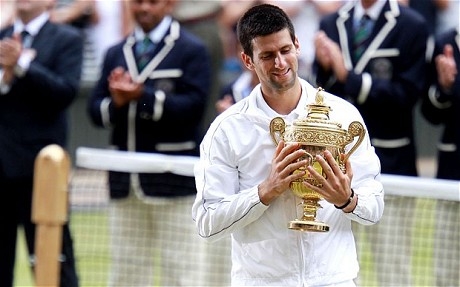
The Arc of a Tennis Champion
This year’s Wimbledon men’s final between Rafael Nadal and Novak Djokovic had the potential to be a classic. Both players are supremely gifted and both have raised their games to heights other players on tour can only dream of reaching. The tightly played first set suggested the match was going to live up to its promise. Just when it appeared neither player was going to be able break the other’s serve, Djokovic elevated his game. He strung together a string of brilliant points to break Nadal’s serve to go up 5-4 and then finished off the set by holding his own serve. But after those riveting opening ten games, the match grew more one-sided. Djokovic further elevated his game in the second set and, uncharacteristically, Nadal couldn’t find a way to match his opponent’s brilliance. He sometimes looked dumbfounded. He did what tennis players often do when they are being outplayed: he went for low percentage shots in a bid to end points early. But those shots often went long or wide or into the net, which accounted for his unusually high number of unforced errors. Nadal is renowned for his unrivaled combination of speed and power. Yet Djokovic’s court coverage was every bit as splendid as Nadal’s and he was able to dominate points from the baseline like no other player can against the Spaniard. Although Nadal dominated the third set, it was less due to his improved play and more due to a prolonged lapse in Djokovic’s concentration and perhaps his self confidence. For a time it looked as though Djokovic didn’t believe he was capable of what he was about to accomplish. But he collected himself enough in the 4th set to again put Nadal on the defensive and seal the victory. In the end, the match’s outcome was anti-climactic.
Nevertheless the final was intriguing for another reason. Strange though it may seem, Djokovic’s victory sheds at least a partial light on the question of who is the greatest player of all time. Until recently the nod was given to Federer. However, Nadal’s phenomenal rise, his ability to dominate Federer and his mastery of the different surfaces is leading some to suggest that it’s not too early to consider him as the best player to ever play the game. As marvelous a player as Nadal surely is, any such declarations are not only premature, but probably wrong as well.
To be sure, Federer’s slight decline has been enough to give Nadal a decided edge in head to

head play. Like no other player has, Nadal got into Federer’s head a few years ago and has taken up permanent residence there. In matches against Nadal, there is a discernible difference in Federer’s body language, particularly when he begins losing. You see it in Federer’s pained facial expressions, in his sometimes slumping shoulders. His discouraged look is usually a harbinger of mental mistakes still to come. Indeed, Federer makes the sort of poor decisions on the court when playing Nadal that he would simply not make against lesser opponents. He looks resigned, as though he knows his graceful, sometimes majestic shot making cannot in the end compete with Nadal’s lethal combination of speed and brute force. As John McEnroe likes to say, Nadal bludgeons Federer into submission.

Commentators, moreover, point out that Nadal has won more major singles titles (ten) by the age of 25 than did Federer by that age. This is true. Yet, although Nadal could surely win more grand slams, there is also a decent chance that he will not win another of the four major tournaments. Such a notion is not as absurd as it may sound if the career of a tennis champion is conceived of as an arc in perpetual flux. Nadal’s rise to the top of the tennis world occurred on the cusp of Federer’s relative decline. This is why some of their matches are regarded as among the greatest ever played. But quietly and somewhat unassumingly, Djokovic’s arc was also beginning its ascent. Just when it seemed Nadal was invincible when playing his best and Federer couldn’t quite dominate like he used to, Djokovic began a remarkable run that included four victories over Nadal in finals of tournaments so far this year. His victory in Sunday’s final runs that string to five. Two of those victories occurred on clay, where Nadal was thought to be unbeatable. From this perspective, Nadal’s arc may be in the very early stages of decline. The point is that any player’s arc can only be measured against that of his peers’. Every important sign suggests Djokovic is beginning to dominate Nadal like Nadal has dominated Federer for the last two or three years. And unlike Federer, Nadal’s game doesn’t seem designed for longevity. At 25 his knees have already suffered mightily for his greatness.
Federer’s arc, by contrast, kept ascending far longer than any player in the modern era.

Not only has Federer won 16 grand slam titles, he has played in 23 grand slam finals. For years he dominated in what seemed an almost effortless fashion. Even when he went very long into every tournament in which he played, he rarely was injured. Even now he seems to not so much run on the court as glide. At 29 and only a few weeks shy of his 30th birthday, the arc of Federer’s career is most definitely on the decline. His loss in to Wilfried Tsonga in Wimbledon’s quarter finals after winning the first two sets confirmed that he cannot always rise to the challenge of beating younger, highly skilled opponents. Yet, somewhat atypically for a tennis player his age, his desire to play and win seems as strong as ever. There was no sense that losing in the quarters did anything to diminish his belief that he can win more grand slam tournaments. This may be wishful thinking, but it stems from his prolonged stretch of unrivaled greatness. For a longer time than has been true of Nadal, Federer was unequaled among his peers. To my mind, this makes Federer the best to ever pick up a tennis racquet.













